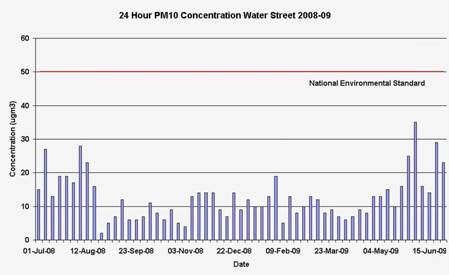Particulate Matter (PM10)
Within this section…
Particulate matter (PM10) is a collective term used to describe very small solid or liquid particles in the air, such as dust, fumes, smoke and fog.
PM10 originates from both natural (wind blown dust, forest fires or pollen) and manmade sources (including automobile exhausts, solid fuel burning and industrial emissions). In Whangarei, the main source of PM10 in winter is solid fuel burning for home heating.
Smoke has high levels of PM10, which is easily inhaled and can harm people's health. People most susceptible to the effects of inhaling PM10 include the elderly, those with existing lung problems, weak hearts or infections such as pneumonia, and children.
PM10 was sampled at two locations in Northland during 2008-09; Water Street and Robert Street in central Whangarei. The results collected are compared to the National Environmental Standard (NES) for PM10, which is not exceeding the limit of 50 micrograms per cubic metre more than once in a twelve month period.
Water Street, Whangarei
Monitoring results from 2008-09 for Water Street indicated that levels of PM10 in the air did not exceed the NES on any occasion. This can be seen in the graph below.

PM10 levels were slightly higher on a number of occasions in winter due to cool, calm conditions that allowed air pollution from domestic fires to build up.
Robert Street, Whangarei
Monitoring results from 2008-09 for Robert Street (Whangarei) indicated that levels of PM10 in the air did not exceed the NES on any occasion. However, PM10 levels were again higher on several occasions in winter due to cool, calm conditions that allowed air pollution from domestic fires to build up.

